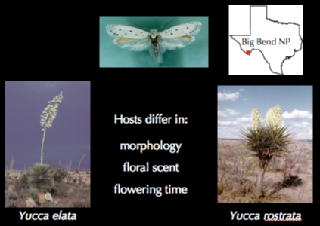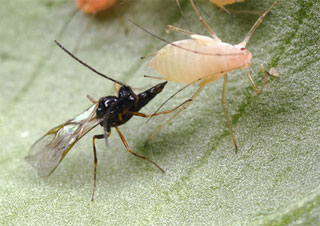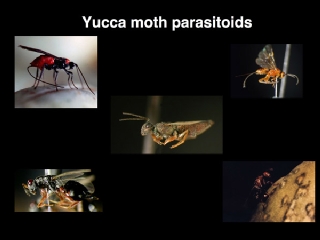Research interests
Species interactions are a central component of biodiversity. I am interested in the role that species interactions have in creating biodiversity and structuring that biodiversity within communities both in ecological and evolutionary time.
My research program centers on two general questions:
1. How does selection generated by species interactions cause population differentiation and speciation?
2. How does the type of interaction influence the rate of diversification between interacting lineages?
Species interactions and speciation
 Host use by plant-feeding insects can lead to the formation of host associated differentiation and ultimately speciation. Bogus yucca moths have repeatedly exhibited host associated differentiation. I am interested in how the link between ecologically important traits and reproductive traits influences population differentiation and incipient speciation.
Host use by plant-feeding insects can lead to the formation of host associated differentiation and ultimately speciation. Bogus yucca moths have repeatedly exhibited host associated differentiation. I am interested in how the link between ecologically important traits and reproductive traits influences population differentiation and incipient speciation.
Species interactions and speciation
 Yuccas are actively pollinated by female moths in the genus Tegeticula that also lay eggs into the flowers. Moth larvae feed on the developing seeds. I am studying whether the pollination mutualism or the seed-eating antagonism is the major driver in moth specialization. That is, are yucca moth species able to pollinate and feed on many yucca species or is the inability to pollinate or feed on seeds driving specialization?
Yuccas are actively pollinated by female moths in the genus Tegeticula that also lay eggs into the flowers. Moth larvae feed on the developing seeds. I am studying whether the pollination mutualism or the seed-eating antagonism is the major driver in moth specialization. That is, are yucca moth species able to pollinate and feed on many yucca species or is the inability to pollinate or feed on seeds driving specialization?
Local adaptation in parasitoid-pea aphid interactions
 Local adaptation of natural enemies has been suggested to be an under-utilized source of improving biocontrol. Pea aphids on alfalfa and clover differ in their resistance to the wasp, Aphidius ervi. Selection experiments and measures of gene flow in natural populations of wasp will be used to test whether repeated introductions of wasps are swamping out local adaptation.
Local adaptation of natural enemies has been suggested to be an under-utilized source of improving biocontrol. Pea aphids on alfalfa and clover differ in their resistance to the wasp, Aphidius ervi. Selection experiments and measures of gene flow in natural populations of wasp will be used to test whether repeated introductions of wasps are swamping out local adaptation.
Host use patterns and speciation in yucca moth parasitoids
 The interaction among yuccas and yucca moths is a textbook example of specialization and coevolution. I am studying the host use patterns and phylogenetics of members of the third trophic level in this interaction to determine if natural enemies exhibit similar patterns of specialization and speciation. I have completed analyses for two of the five genera and plan on continuing research on the other three to generate a comprehensive picture of specialization, coevolution, and speciation in this well-known system. Click here to learn more.
The interaction among yuccas and yucca moths is a textbook example of specialization and coevolution. I am studying the host use patterns and phylogenetics of members of the third trophic level in this interaction to determine if natural enemies exhibit similar patterns of specialization and speciation. I have completed analyses for two of the five genera and plan on continuing research on the other three to generate a comprehensive picture of specialization, coevolution, and speciation in this well-known system. Click here to learn more.
